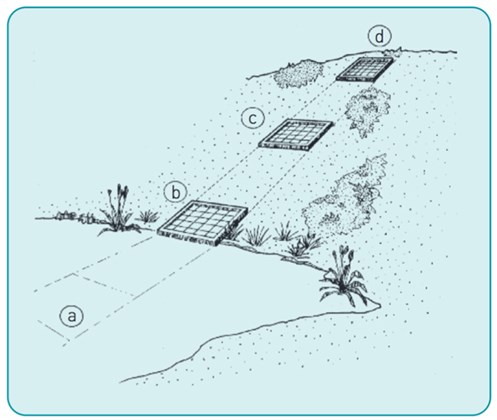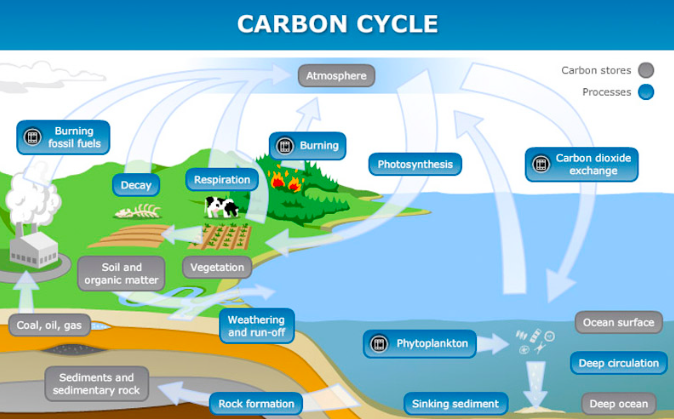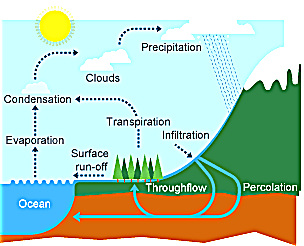Recyling Materials
Field Work Techniques
A range of fieldwork techniques can be used to determine the number of organisms in a given area.
A lightmeter can be used to used to measure the light intensity. This can be useful when looking the things that can affect the rate of photosynthesis.
A quadrat can be used to count up the number of plants in a square metre. It is a grid that is placed on the ground, and organisms can be counted up based on the type of species that are found. They are placed randomly so that there is no bias, and it is more reliable to compare within different locations.
A transect can be used to record data at regular intervals. It is a straight line that is placed across a location, and a quadrat will be placed at random intervals along the transect so that the species can be counted up.
Materials Cycle
Different materials cycle through the abiotic and biotic components of an ecosystem.
Physical abiotic factors such as temperature, light and humidity may change, but it is the chemical abiotic factors such as water, carbon, nitrogen, sulfur and oxygen that can be recycled. They will recycle by being transferred from one factor to another. All materials in the living world are recycled to provide the building blocks for future organisms.
Biotic factors are the living things within an ecosystem, therefore it cannot be recycled. They tend to reproduce then die as a whole.
Carbon Cycle
- When plants and animals decompose, carbon compounds are released into the soil. They are broken down by bacteria, which then releases the carbon back into the atmosphere.
- Carbon returns into plants through photosynthesis.
- When plants decay or is burned, they release carbon into the atmosphere in the form of carbon dioxide.
- When plants are eaten, the carbon is transferred from the plant to the animal.
Water Cycle
- Also known as the hydrologic cycle
- Sun provides the energy for water cycle to take place
- Water is found in the atmosphere as water vapour through the process of evaporation, transpiration and sublimation.
- Water returns to the earth through precipitation as rain, snow, sleet or hail.
- Water seeps into the ground, and the plants and animals will take up some water. The rest of the water returns to the river and streams, then back into the ocean.
- Some of the water will soak into the soil and rocks as groundwater. Some will be soaked deep in the soil, filling up the underground aquifers.
- Providing drinking water through precipitation. However the water needs to be distilled through the process of thermal distillation. This removes the salt content in the precipitation, so that pure water is created.
Composting
The rate of decomposition in composting can be affected by the temperature, water content and oxygen availability.
- Colder temperatures will affect decomposing organisms so that they are less active
- At extremely high temperatures, decomposers will be killed, therefore decomposition will stop
- Low levels of water will mean that the decomposers cannot survive
- High levels of water will increase the rate of decomposition, as decomposers tend to secrete enzymes onto decaying matters, then it absorbs any dissolved molecules.
- High levels of oxygen will encourage decomposers to survive as they require oxygen to respire and survive.
Decay
It is possible to calculate rate changes in the decay of biological material through the following formula:
This shows how quickly something is able to decay. We can use this formula to calculate the decay of specific substances (e.g. milk). We can see the change in pH value of milk when it is spoilt, as spoilt milk becomes acidic.
Gardeners and farmers try to provide optimum conditions for rapid decay of waste biological material. The compost produced is used as a natural fertiliser for growing garden plants or crops. Anaerobic decay produces methane gas. Biogas generators can be used to produce methane gas as a fuel.
- What is the use of a light meter?
- Your answer should include: Measure / Light / Intensity
- How will high levels of water affect the rate of decomposition?
- Your answer should include: Increase / Rate / Decomposition / Secrete / Enzymes / Decaying / Matters / Absorbs / Dissolved / Molecules
Explanation: High levels of water will increase the rate of decomposition, as decomposers tend to secrete enzymes onto decaying matters, then it absorbs any dissolved molecules. - What happens during the process of thermal distillation?
- Your answer should include: Salt / Content / Precipitation / Removed / Pure / Water / Created
Explanation: During thermal distillation, salt content in the precipitation is removed so that pure water is created.




